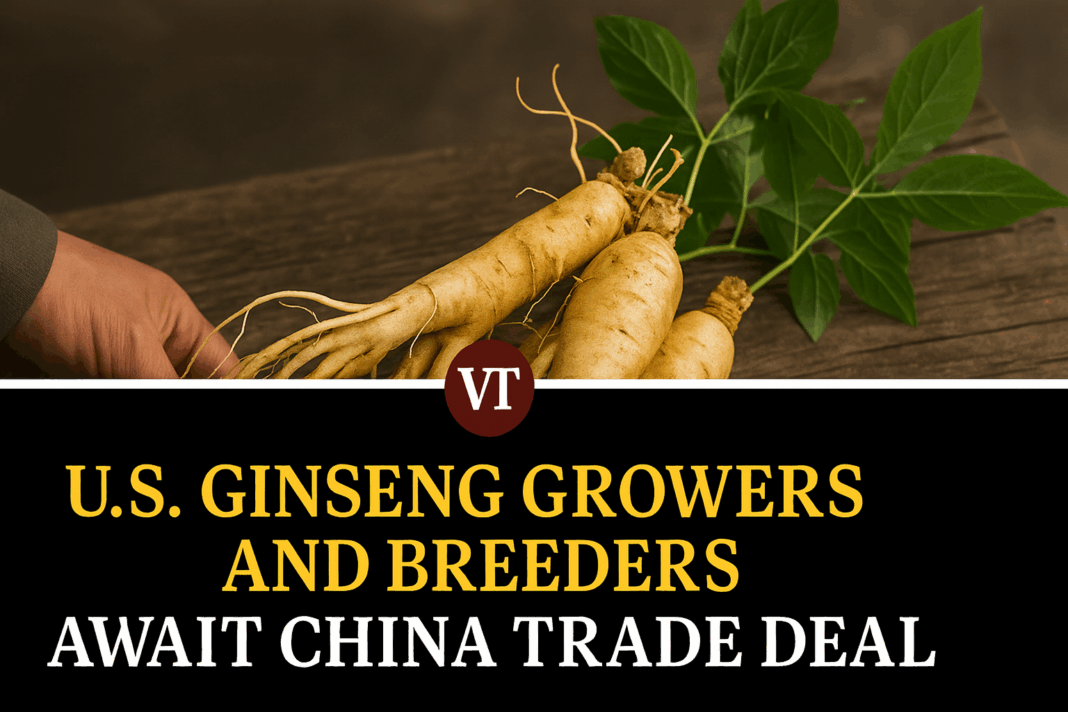By Hope Kirwan, Iowa Capital Dispatch | Published June 30, 2025
This article is republished from Iowa Capital Dispatch under a Creative Commons license. Edits for style may have been made by Virginia Times.
In a warehouse north of Wausau, Wisconsin, thousands of cardboard boxes full of dried ginseng are stacked and waiting at Hsu’s Ginseng Enterprises.
It’s one of the largest growers of the specialty crop in Wisconsin, where almost all U.S. ginseng is grown. Will Hsu, the company’s president, said there’s something special about the region’s soil and climate, what the French call “terroir.”
“Customers over the last 100 some years have gotten used to this taste and flavor, probably no different than wine connoisseurs feel about Napa Valley or France,” he said.
American ginseng is a staple of Chinese medicine, offering a cooling or tonifying effect that contrasts the more fiery ginseng native to Asia. The slightly bitter, herbal-tasting roots are mostly sold dried, but can also be processed into powders and teas.
Hsu sells about half of his annual crop directly from the U.S., offering direct-to-consumer sales online, through duty-free shops at airports or through Chinese pharmacies and grocery stores. The other half is exported to processors in Asia, mostly in mainland China, Taiwan and Hong Kong. But these sales have largely been put on hold this year due to the back-and-forth exchange of retaliatory tariffs started shortly after President Donald Trump took office.
While other types of agricultural producers can shift sales to domestic or alternative international markets, Hsu said ginseng producers don’t have that option. He’s still holding more than 80% of his 2024 crop.
“There is no other market in the world that will consume this much ginseng,” he said.
At the height of the tariff exchange in April, China placed a 117% tariff on U.S. ginseng. When the two countries agreed to a 90-day pause in May, the import tax dropped to 32.5% — the level it was at the end of Trump’s first term.
Hsu urged his buyers to take advantage of the tariff pause, including a customer who already paid a deposit on a $1 million shipment. Still, some companies are holding out, hoping for a better rate as trade talks continue. Trump announced in early June that a new trade agreement had been reached, but details remain unreleased.
“That’s the risk in this environment, when it’s changing: it could get better, but you have to think about the flip that it could get worse,” Hsu said. “And if it gets worse, how long are you going to let this product sit here?”
Some Ag Products Have Few Alternative Buyers
Ginseng isn’t alone. The U.S. pork industry exports around 55% of pork offal — kidneys, liver, tongue — to China, according to the National Pork Producers Council. These cuts, common in Chinese cuisine but less popular in the U.S., saw prices drop during the April tariff exchange. They’ve since rebounded, thanks to the 90-day pause.
“I think it highlights that there is international demand, and that the tariffs do matter,” said David Anderson, an ag economist at Texas A&M University.
Muscle cuts of pork have also bounced back during the pause. But Anderson cautioned that the two categories are different markets. Offals are typically cheaper and more desirable in lower-income countries, meaning fewer global buyers exist if Chinese demand declines.
“A lot of times culture matters,” he added. “Some places eat these items and some don’t.”
Competitors Gaining Ground
In Missouri, Tony Clayton of Clayton Agri-Marketing has exported live pigs, cattle and other livestock to China and 60+ countries for decades. He calls U.S. livestock genetics the “gold standard.”
But even before Trump’s return to office, Clayton said Chinese import protocols were already among the strictest: 60 days of blood testing pre-shipment, followed by a 45-day post-arrival quarantine.
He had nearly 900 pigs ready for export to China in June — until tariffs resumed in April. Now, he’s scrambling to get them out before the pause ends in August.
“You don’t slow biology down; the pigs still grow,” Clayton said. “We’re in a completely different set of animals than we had previously selected.”
He also fears lasting reputational damage to the U.S. as a reliable exporter. “There’s not a week that goes by that I don’t have three to four customers ask, ‘What’s happened to the United States?’”
Clayton said the uncertainty gives competitors like Australia and the EU a chance to gain ground — not just in China, but in other nations hit by Trump’s tariffs, including Mexico.
Producers Forced to Cut Back
Back in Wisconsin, Hsu sees the same trend. Chinese and Canadian growers already offer cheaper ginseng, and U.S. tariffs make Wisconsin products even pricier. “It’s very hard then to convince them to go back to something that is more expensive once they’ve swapped to a cheaper substitute,” he said.
Ginseng takes 3–5 years to mature, making quick adjustments to global markets nearly impossible. Hsu said he’s planting fewer acres this year, uncertain how trade relations will evolve by the next harvest season.
This story was produced in partnership with Harvest Public Media, a collaboration of public media newsrooms covering food systems, agriculture and rural issues across the Midwest and Great Plains.
Original source: Iowa Public Radio – Harvest Public Media
Republished with permission from: Iowa Capital Dispatch. Original article by Hope Kirwan. Minor edits for style by Virginia Times.
A global media for the latest news, entertainment, music fashion, and more.















